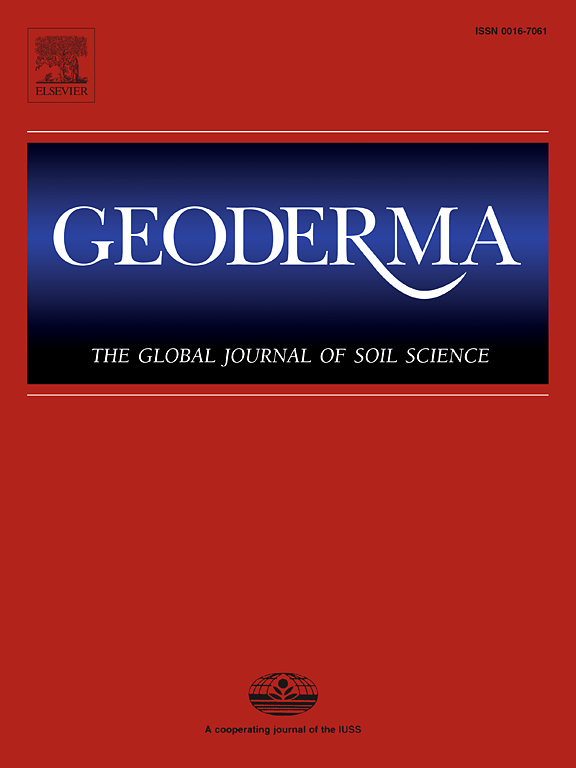Mechanism insights into amendments enhanced dendroremediation for Cd and Zn-polluted soil: Bacterial co-occurrence networks’ complexity and stability
IF 5.6
1区 农林科学
Q1 SOIL SCIENCE
引用次数: 0
Abstract
Soil amendments enhance phytoremediation utilizing trees, have attracted considerable attention because of their low cost, great benefits and huge potential. It’s demonstrated that amendments facilitate the metal immobilization via adjusting soil pH and metal availability, while the underlying mechanism on amendments improving phytoremediation efficiency remains unclear. In our previous studies, the phytoremediation efficiency of Quercus spp. for Cd and Zn was improved by application of soil amendments in a three-year field trial located in Hangzhou, China. Here, we collected the soil samples from the above mentioned experiment and further compared the characteristics of the rhizosphere bacterial community of Quercus texana and Quercus fabri amended with rice straw biochar, palygorskite, and a combination of rice straw biochar and palygorskite in Cd- and Zn-contaminated soils. There were no significant differences in bacterial diversity between the Q. texana and Q. fabri, which were characterized by a high and low accumulation of heavy metals. However, rhizosphere bacterial network of both species exhibited significant responses to the different soil amendments. Combined biochar increased the complexity and stability of bacterial networks, which was manifested mainly as an increase in network cohesion, negative:positive cohesion, and robustness. Partial least squares path modeling demonstrated that network stability was directly influenced by complexity (path coefficient = 0.551, p < 0.05) and keystone taxa (path coefficient = -0.29, p < 0.05), where keystone taxa can serve as a significant predictor variable for network stability. Furthermore, network complexity and stability were significantly correlated with heavy metal accumulation in Quercus spp., suggesting potential linkages between microbial network properties and phytoremediation efficiency. Together, the results emphasize that combined biochar enhances the complexity and stability of rhizosphere bacterial network, ultimately improving phytoremediation efficiency and biomass. Lower network stability in the rice straw biochar and palygorskite treatments may pose ecological risks. These novel findings provide important insights into optimizing amendments to improve phytoremediation efficiency by affecting rhizosphere microbial interactions.

对镉和锌污染土壤的强化树枝修复修正剂的机理研究:细菌共生网络的复杂性和稳定性
土壤改良剂利用树木提高植物修复效果,因其成本低、效益大、潜力巨大而备受关注。研究表明,土壤改良剂可通过调节土壤酸碱度和金属可得性促进金属固定,但土壤改良剂提高植物修复效率的内在机制仍不清楚。在我们之前的研究中,在中国杭州进行的一项为期三年的田间试验中,施用土壤改良剂提高了柞树对镉和锌的植物修复效率。在此,我们采集了上述试验的土壤样本,并进一步比较了在镉和锌污染土壤中,经稻草生物炭、褐铁矿以及稻草生物炭和褐铁矿组合改良的枹栎和枹栎根圈细菌群落的特征。Q. Texana 和 Q. fabri 的细菌多样性没有明显差异,这两种土壤的重金属积累量有高有低。不过,这两个物种的根瘤细菌网络都对不同的土壤改良剂表现出明显的反应。复合生物炭增加了细菌网络的复杂性和稳定性,主要表现为网络内聚力、负正内聚力和稳健性的增加。偏最小二乘法路径模型表明,网络稳定性受复杂性(路径系数 = 0.551,p < 0.05)和关键类群(路径系数 = -0.29,p < 0.05)的直接影响,其中关键类群可作为网络稳定性的重要预测变量。此外,网络的复杂性和稳定性与栎属植物的重金属积累显著相关,表明微生物网络特性与植物修复效率之间存在潜在联系。总之,研究结果表明,复合生物炭能增强根瘤菌网络的复杂性和稳定性,最终提高植物修复效率和生物量。稻草生物炭和叶蜡石处理中较低的网络稳定性可能会带来生态风险。这些新发现为优化添加剂提供了重要启示,有助于通过影响根圈微生物的相互作用来提高植物修复效率。
本文章由计算机程序翻译,如有差异,请以英文原文为准。
求助全文
约1分钟内获得全文
求助全文
来源期刊

Geoderma
农林科学-土壤科学
CiteScore
11.80
自引率
6.60%
发文量
597
审稿时长
58 days
期刊介绍:
Geoderma - the global journal of soil science - welcomes authors, readers and soil research from all parts of the world, encourages worldwide soil studies, and embraces all aspects of soil science and its associated pedagogy. The journal particularly welcomes interdisciplinary work focusing on dynamic soil processes and functions across space and time.
 求助内容:
求助内容: 应助结果提醒方式:
应助结果提醒方式:


